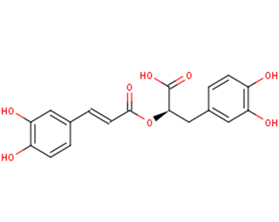
Rosmarinic acid
CAS No. 20283-92-5
Rosmarinic acid( Rosmarinic acid | Labiatic acid | RM 21A | NPLC-0542 | NPLC0542 )
Catalog No. M18210 CAS No. 20283-92-5
Rosmarinic acid has shown to contain antioxidant, anti-inflammatory and antimicrobial activities.
Purity : >98% (HPLC)
 COA
COA
 Datasheet
Datasheet
 HNMR
HNMR
 HPLC
HPLC
 MSDS
MSDS
 Handing Instructions
Handing Instructions
| Size | Price / USD | Stock | Quantity |
| 50MG | 60 | In Stock |


|
| 100MG | Get Quote | In Stock |


|
| 200MG | Get Quote | In Stock |


|
| 500MG | Get Quote | In Stock |


|
| 1G | Get Quote | In Stock |


|
Biological Information
-
Product NameRosmarinic acid
-
NoteResearch use only, not for human use.
-
Brief DescriptionRosmarinic acid has shown to contain antioxidant, anti-inflammatory and antimicrobial activities.
-
DescriptionRosmarinic acid has shown to contain antioxidant, anti-inflammatory and antimicrobial activities. Possesses promising physiological actions related to cognitive performance, Alzheimer′s disease prevention, kideney disease treatment, cardioprotection and cancer chemoprevention.(In Vitro):Rosmarinic acid (RA) shows an in vitro multifunctional profile characterized by antioxidant effects, and monoamine oxidases (MAO-A and MAO-B) and catechol-O-methyl transferase (COMT) inhibition. Rosmarinic acid shows antioxidant effects against hydroxyl (HO(?)) and nitric oxide (NO) radicals (IC50 of 29.4 and 140 μM, respectively), and inhibition of lipid peroxidation (IC50 of 19.6 μM). Rosmarinic acid (RA) exerts a significant cytoprotective effect by scavenging intracellular ROS induced by UVB. In H2O2-treated cells, 2.5 μM Rosmarinic acid scavenges 60% of intracellular ROS compared to 77% of intracellular ROS scavenging effect in N-acetyl-L-cysteine (NAC).(In Vivo):Rosmarinic acid (RA) is a widespread phenolic ester compound in the plants, particularly those in the Labiatae family of herbs, such as Rosmarinus officinali, Salvia miltiorrhiza, and Prunella vulgaris. Rosmarinic acid suppresses colonic inflammation in dextran sulphate sodium (DSS)-induced mice via dual inhibition of NF-κB and STAT3 activation. In the DSS-induced colitis model, Treatment with Rosmarinic acid (30, 60?mg/kg, p.o.) markedly attenuates the production of cytokines.
-
In VitroRosmarinic acid (RA) shows an in vitro multifunctional profile characterized by antioxidant effects, and monoamine oxidases (MAO-A and MAO-B) and catechol-O-methyl transferase (COMT) inhibition. Rosmarinic acid shows antioxidant effects against hydroxyl (HO(?)) and nitric oxide (NO) radicals (IC50 of 29.4 and 140 μM, respectively), and inhibition of lipid peroxidation (IC50 of 19.6 μM). Rosmarinic acid (RA) exerts a significant cytoprotective effect by scavenging intracellular ROS induced by UVB.In H2O2-treated cells, 2.5 μM Rosmarinic acid scavenges 60% of intracellular ROS compared to 77% of intracellular ROS scavenging effect in N-acetyl-L-cysteine (NAC).
-
In VivoRosmarinic acid (RA) is a widespread phenolic ester compound in the plants, particularly those in the Labiatae family of herbs, such as Rosmarinus officinali, Salvia miltiorrhiza, and Prunella vulgaris. Rosmarinic acid suppresses colonic inflammation in dextran sulphate sodium (DSS)-induced mice via dual inhibition of NF-κB and STAT3 activation. In the DSS-induced colitis model, Treatment with Rosmarinic acid (30, 60?mg/kg, p.o.) markedly attenuates the production of cytokines.
-
SynonymsRosmarinic acid | Labiatic acid | RM 21A | NPLC-0542 | NPLC0542
-
PathwayOthers
-
TargetOther Targets
-
RecptorMAO-A| MAO-B| COMT
-
Research AreaOthers-Field
-
Indication——
Chemical Information
-
CAS Number20283-92-5
-
Formula Weight360.33
-
Molecular FormulaC18H16O8
-
Purity>98% (HPLC)
-
SolubilityDMSO : ≥ 30 mg/mL; 83.26 mM
-
SMILESc1cc(c(cc1C[C@H](C(=O)O)OC(=O)/C=C/c1cc(c(cc1)O)O)O)O
-
Chemical Name(R,E)-3-(3,4-dihydroxyphenyl)-2-((3-(3,4-dihydroxyphenyl)acryloyl)oxy)propanoic acid
Shipping & Storage Information
-
Storage(-20℃)
-
ShippingWith Ice Pack
-
Stability≥ 2 years
Reference
1. Lee JW, et al. Mol Nutr Food Res. 2015 Mar;59(3):386-400.
molnova catalog



related products
-
Arnidiol
Arnidiol is a pentacyclic triterpene isolated from Barleria Longiflora Linn FArnidiol has anti-inflammatory activity, it possesses marked inhibitory activity against 12-O-tetradecanoylphorbol-13-acetate (TPA)-induced inflammation in mice.
-
ML329
ML329 is a small molecule inhibitor of MITF, inhibiting TRPM-1 promoter activity.
-
Ac-IEVDIDVEH (TFA)
Ac-IEVDIDVEH TFA is a short peptide sequence with Ac at the end.



 Cart
Cart
 sales@molnova.com
sales@molnova.com


